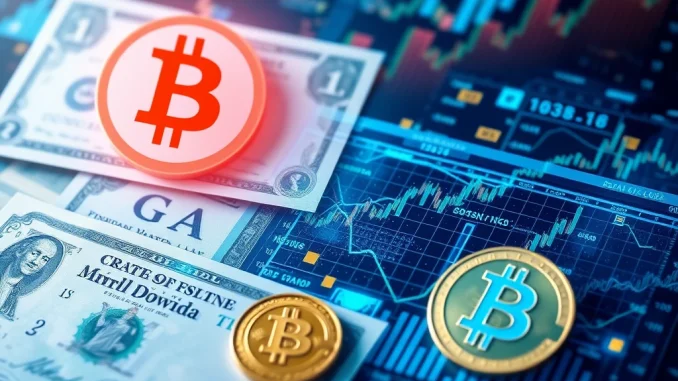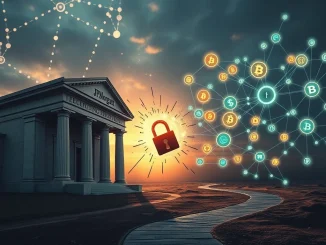
Imagine a future where your digital wallet doesn’t just hold crypto, but also a piece of U.S. government debt. This isn’t science fiction; it’s a potential reality highlighted by none other than U.S. Treasury Secretary Scott Bessent. He recently shared a remarkable outlook: **Digital Assets** could unlock a staggering $2 trillion in new demand for **U.S. Treasury Bonds**. This insight, initially reported by @blckchaindaily on X, points to a significant intersection between the burgeoning world of digital finance and the bedrock of traditional global markets – government debt.
How Can Digital Assets Impact the Bond Market?
The core idea is that leveraging digital asset technology, particularly **Tokenization**, can make traditional assets like Treasury bonds more accessible, liquid, and efficient to trade. Think of tokenization as converting the rights to an asset (like a bond) into a digital token on a blockchain. This can:
- Increase Accessibility: Break down large bond denominations into smaller, fractional tokens, allowing more investors (both retail and institutional globally) to participate.
- Improve Liquidity: Enable 24/7 trading on digital platforms, unlike traditional bond markets with limited hours.
- Reduce Costs: Streamline settlement processes by potentially cutting out intermediaries and reducing transaction fees.
- Expand Investor Base: Attract investors already active in the digital asset space who might not currently engage with traditional bonds.
This potential influx of capital, driven by increased **Crypto Demand** for tokenized financial products, is what Secretary Bessent’s statement likely refers to. It’s about tapping into a new pool of wealth and making the mechanics of buying and selling bonds smoother.
What Does $2 Trillion in New Demand Mean for the U.S. Treasury Bonds?
A $2 trillion increase in demand is substantial. The U.S. Treasury issues bonds to finance government operations and manage national debt. Higher demand generally leads to:
- Lower Borrowing Costs: When demand is high, the Treasury can sell bonds at lower interest rates, saving taxpayers money on debt servicing.
- Increased Market Efficiency: A more liquid and accessible **Bond Market** is more robust and attractive globally.
- Validation for Digital Assets: Integration into such a fundamental traditional market lends significant credibility to the digital asset ecosystem.
It suggests that policymakers are seriously considering the practical benefits that digital finance technologies can bring to established financial systems, moving beyond just focusing on regulatory concerns.
Tokenization: The Key to Unlocking This Potential?
While Secretary Bessent’s comment is brief, the most plausible path for **Digital Assets** to generate such demand is through **Tokenization**. Several projects and institutions are already exploring tokenizing various real-world assets, including real estate, equities, and debt. Tokenizing Treasury bonds would essentially create a digital twin on a blockchain, inheriting the security and settlement benefits of distributed ledger technology while representing the underlying, low-risk government debt.
Consider the traditional bond market versus a tokenized one:
| Feature | Traditional Bond Market | Tokenized Bond Market (Potential) |
|---|---|---|
| Access | Often high minimums, complex processes | Fractional ownership, potentially simpler digital platforms |
| Trading Hours | Limited business hours | 24/7 trading possible |
| Settlement | Multi-day process (T+2, T+3) | Near-instant or significantly faster settlement |
| Liquidity | Varies by bond type and market conditions | Potentially higher due to broader access and 24/7 trading |
| Cost | Broker fees, custodian fees | Potentially lower transaction costs |
This comparison highlights why **Tokenization** is seen as a powerful tool to modernize and expand participation in the **Bond Market**.
Challenges and Considerations
While the potential is exciting, integrating **Digital Assets** into the **U.S. Treasury Bonds** market isn’t without hurdles. Key considerations include:
- Regulatory Clarity: Establishing clear rules for issuing, trading, and holding tokenized bonds.
- Technology Standards: Ensuring interoperability between different blockchain platforms and traditional financial infrastructure.
- Security: Protecting against hacks, fraud, and operational risks in a digital environment.
- Investor Protection: Ensuring tokenized bonds are sold and managed in a way that protects investors.
- Market Structure: Adapting existing market plumbing and legal frameworks to accommodate digital native assets.
Addressing these challenges will be crucial to realizing the $2 trillion potential and ensuring the stability and integrity of the **Bond Market**.
What Does This Mean for Crypto and Finance?
Secretary Bessent’s statement is a strong signal that the U.S. government is observing and potentially planning for the impact of **Digital Assets** on mainstream finance. For the crypto world, it’s validation that the underlying technology (like blockchain for **Tokenization**) has applications far beyond speculative trading. For traditional finance, it’s a call to explore innovation and efficiency gains offered by digital asset technology.
Increased **Crypto Demand** for tokenized real-world assets, particularly something as stable and significant as **U.S. Treasury Bonds**, could bridge the gap between the two financial worlds, bringing new liquidity and potentially reducing volatility in the crypto space by linking it to traditional asset stability.
Conclusion: A Glimpse into the Future of Finance
The prospect of **Digital Assets** driving up to $2 trillion in demand for **U.S. Treasury Bonds**, as suggested by Treasury Secretary Scott Bessent, paints a compelling picture of the future of finance. It underscores the transformative potential of **Tokenization** and highlights how **Crypto Demand**, channeled into regulated, real-world assets, could benefit traditional markets. While significant work remains in regulation and infrastructure, this outlook from a key U.S. financial official is a powerful indicator that the integration of digital and traditional finance is not just coming – it’s already being factored into the highest levels of economic planning. This potential massive boost could redefine how we think about investing in government debt and the role of digital assets in the global economy.



